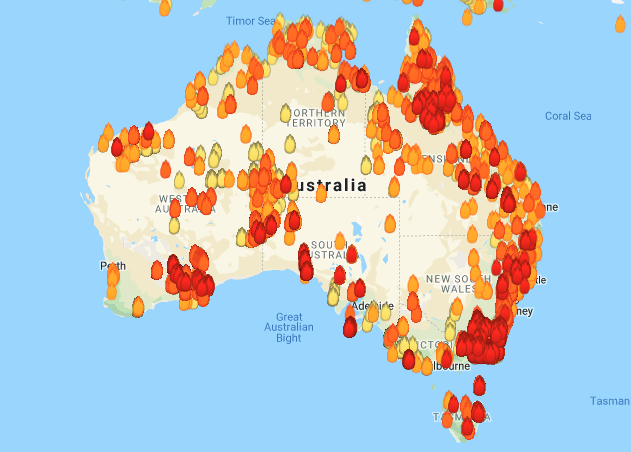Australia is facing an unprecedented national crisis, bushfires are tearing through rural communities across the nation. Since September the fires have burnt an estimated 6,300,000 hectares (16,000,000 acres; 63,000 km2; 24,000 sq mi), destroyed over 2,500 buildings (including over 1,300 houses) and killed 25 people as of the 5th January 2020, with a further six missing in the state of Victoria. To put that into perspective, the 2019 Amazon rainforest fires burned more than 900,000 hectares (about 2.22 million acres). In California, which is known for its deadly wildfires, just over 100,000 hectares (247,000 acres) burned in 2019, and about 1,800,000 hectares (4.47 million acres) in 2018.
The bushfires here are regarded as one of the worst bushfire seasons in memory. The scale of the threat is immense, and fires continue to burn, with authorities calling for people to evacuate their homes as the country braces for another weekend of catastrophic danger. Australians caught up in the crisis are taking to social media and pleading for help. Entire towns have been flattened as fires snake through bushland, across highways, jump over rivers and climb up mountains. In New South Wales and Victoria, the most populous states in the country, people tried to outrun the blaze and highways were clogged with cars. In major cities, such as Sydney and Melbourne, a dense smoke has descended over the metropolitan areas like a blanket. Some regions of the country recorded air quality measurements 20 times above the hazardous level. Canberra, the nations capital, recorded an air quality reading of 913.
The bushfires here are regarded as one of the worst bushfire seasons in memory. The scale of the threat is immense, and fires continue to burn, with authorities calling for people to evacuate their homes as the country braces for another weekend of catastrophic danger. Australians caught up in the crisis are taking to social media and pleading for help. Entire towns have been flattened as fires snake through bushland, across highways, jump over rivers and climb up mountains. In New South Wales and Victoria, the most populous states in the country, people tried to outrun the blaze and highways were clogged with cars. In major cities, such as Sydney and Melbourne, a dense smoke has descended over the metropolitan areas like a blanket. Some regions of the country recorded air quality measurements 20 times above the hazardous level. Canberra, the nations capital, recorded an air quality reading of 913.
Looking out my window just now the sky is full of smoke and the sun is orange, but although we are ok here in Brisbane, the situation is extremely grim down south. Australians are exhausted, frustrated and frightened. Many have had to flee their homes not knowing if they will be there when they return.. With fire conditions predicted to get worse in the coming days, help is desperately required. Yesterday the Prime Minister Scott Morrison announced 3,000 Australian Defence Force reservists would be deployed to fire recovery efforts across the nation.
A fire tracker map maintained by researchers in Western Australia shows fires burning across the country, with fires raging on the southeast coast of Victoria.

Wildfires burning across Australia on Jan. 3, 2020.
Landgate's MyFireWatch
Ecologists at the University of Sydney believe that an estimated 480 million mammals, birds, and reptiles have died in the bushfires, which have been burning across Australia since September. Eight thousand of the animals deaths are believed to be koalas, that's around 30% of the Koala population.
Why are the fires so bad?
Fire season in Australia is always dangerous but conditions have been unusually severe this year, fanning the flames and making firefighting conditions particularly difficult. Australia is experiencing one of its worst droughts in decades -- the country's Bureau of Meteorology said in December that last spring was the driest on record. Meanwhile, a heatwave in December broke the record for highest nationwide average temperature, with some places sweltering under temperatures well above 40 degrees Celsius (about 113-120 degrees Fahrenheit). Strong winds have also made the fires and smoke spread more rapidly, and have led to fatalities -- a 28-year-old volunteer firefighter died in NSW in December after his truck rolled over in high winds. On New Year's Day 2020 a blanket of smoke from the Australian fires covered the whole South Island of New Zealand, giving the sky an orange-yellow haze. People in Dunedin also reported smelling smoke in the air. I have seen images of ash settling on the snow peaks in and around Queenstown New Zealand. There are over 2,300 firefighters working on the ground in New South Wales alone, and more support is on the way -- the US, Canada, and New Zealand have sent additional firefighters to help. As I was researching just now I read the USA and Canada are sending more firefighters, more equipment and a disaster team and will arrive in the next day or so.
My thoughts and thanks go out to everyone who are putting their lives on the line to save this country of ours. How can you possibly thank someone who is so selfless, someone who has given up their own time, left their homes, their jobs and most importantly their families to fight on the front line to keep us safe. They fight night and day and have never given up. Words cannot explain the pride and gratitude we have for you all. Please stay safe and lets hope you can all go home to your families very soon. Then there are the volunteers who are feeding them and keeping them hydrated and safe, the volunteers who are rescuing injured and frightened animals. To you all we say "THANK YOU"



No comments:
Post a Comment